Customer service staff in the Mill Creek Regional Office are available for walk-in service 10 a.m. to 2 p.m. Monday, Tuesday, Wednesday, and Friday, and 12:00 p.m. through 4:00 p.m. on Thursday.
16018 Mill Creek Boulevard
Mill Creek, WA 98012-1541
United States
Fishing tips and news
New to fishing in Washington? Check out our Fish Washington blog post for a guide on how to get started.
2024-25 Sport Fishing Rules
The latest fishing regulations went into effect July 1. The 2024-25 Washington Sport Fishing Rules pamphlet is now available online and will soon be at hundreds of license dealers around the state.
Current fishing regulations and emergency Fishing Rule Changes are also available online at wdfw.wa.gov/fishing/regulations.
Winter crabbing opens in several marine areas
Several Puget Sound marine areas have reopened for the recreational crab fishing winter season. Learn more in our news release and on our recreational crab regulations webpage. In each area, crabbing will be allowed seven days a week through Dec. 31.
Crabbing will not immediately reopen for winter in Marine Area 10 (Seattle-Bremerton Area) and Marine Area 11 (Tacoma-Vashon Island) due to limited share remaining following the summer recreational fishery.
Fishery managers will re-evaluate the harvest estimates from Marine Areas 10 and 11 after the CRC reporting period closes and all data is entered to determine if enough quota remains to allow a winter fishery.
Report invasive European green crab
European green crab are infrequently encountered by recreational crabbers and shellfish gatherers in Washington's coastal bays, as well as sites in the Strait of Juan de Fuca, Bellingham Bay, Drayton Harbor, and the San Juan Islands. This harmful invasive species is a shore crab typically found in shallow water less than 25 deep, including estuaries, tidal sloughs, shellfish and eelgrass beds, and mudflats. WDFW recently released a new six-year management plan for green crabs; learn more in our news release.
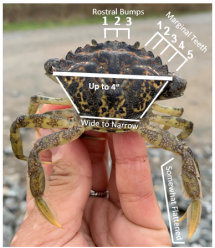
If you find a suspected European green crab (EGC) or its shell in Washington, take photos and report it as soon as possible at wdfw.wa.gov/greencrab or through the Washington Invasive Species Council’s WA Invasives mobile app.
Currently, WDFW is not asking the public to kill suspected EGC. This is to protect native crab species, which are often misidentified, particularly helmet, kelp, and hairy shore crabs. Crab identification guides and resources are available on our website and on the European green crab online hub.
European green crabs are classified by Washington state as a prohibited invasive species, making it illegal to retain, possess, or transport them alive. Targeting EGC with traps requires a permit from WDFW's Aquatic Invasive Species (AIS) unit. For those who own or manage shellfish beds, beaches, or tidelands, support and permits for European green crab control may be available. Please contact ais@dfw.wa.gov.
Under Washington state regulations, prohibited invasive species may be killed and returned to the water where they were found, or retained once dead, if the person is certain about species identification and assumes responsibility for correct identification and adherence to state rules and fishing regulations. More information on EGC regulations is available on WDFW’s webpage and in the 2024-25 Sport Fishing Rules.
Salmon fishing in Snohomish, Stillaguamish, and other rivers

Several rivers across the North Puget Sound Region are open for salmon fishing in October, including the Snohomish, Skagit, mainstem Stillaguamish, mainstem Nooksack, and Green rivers.
Coho salmon are the main prize in October, though chum salmon are also a popular target in certain rivers such as the Green. Fall Chinook are open in a portion of the Nooksack River. Steelhead may also be encountered in several rivers; check our webpage for hatchery steelhead plants.
Be sure to review the fishing regulations (including any emergency rule changes) or the Fish Washington mobile app for detailed rules.
For tips on river fishing for salmon and steelhead, visit our webpage.
Puget Sound coho and chum salmon fishing
While Marine Area 9 (Admiralty Inlet) is now closed for the season, salmon fishing for coho and chum salmon remains open in marine area 10 (Seattle/Bremerton area) and 11 (Tacoma/Vashon area). Marine Area 13 (South Puget Sound) is also open for salmon fishing year-round.
Be sure to double-check the fishing regulations and emergency rule changes or Fish Washington mobile before hitting the water.
For tips on salmon fishing in marine areas, visit our webpage. Or check out our recent blog post on coho fishing from shore including public beaches and points.
Releasing salmon properly
Selective fisheries for hatchery-produced salmon and catch-and-release fisheries are increasingly important to providing recreational fishing opportunities around Washington. To ensure these salmon fisheries are successful long-term, it is vital that anglers do their part to comply with all regulations, especially how to properly release unmarked and out-of-season fish to improve their survival.
For more information, watch our YouTube video on safe salmon handling or read our blog post about how to properly release salmon.
High mountain trout lakes
Many high elevation or alpine trout lakes remain accessible this month for hikers packing their fishing rods. Though be sure to check trail reports and weather forecasts before heading out!
Hundreds of "high lakes", ranging from about 3,000 to 6,000 feet in elevation, lie on public land in the Cascade Mountains for anglers to check out.
Read about the history of Washington’s high lakes, find fishing tips, and discover popular alpine lakes throughout the state in our latest blog post.
Anglers should also review the Washington Sport Fishing Rules pamphlet or Fish Washington mobile app for the lake or stream they plan to fish before heading out.
Several beaches reopen for shellfish gathering

Always check the WDFW regulations for public beaches in your area as well as the Washington State Department of Health (DOH)’s Shellfish Safety Map at doh.wa.gov/shellfishsafety.
WDFW works closely with DOH to ensure safe, legal harvest of shellfish on state beaches. In order to safely and legally harvest shellfish for human consumption, both the DOH health status and the WDFW season for a beach must be OPEN.
For open beaches, be sure to chill shellfish on ice or refrigerate immediately after gathering to slow the growth of harmful bacteria like Vibrio. The DOH shellfish illness prevention webpage has more tips and information.
Lowland lakes trout fishing, trout derby open through October
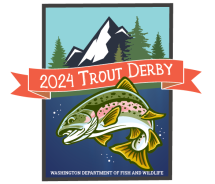
The statewide lowland lakes trout-fishing season is now open. Search for local fishing spots, with information on bank access, what’s in the water, and when it’s biting on our lowland lakes page. You can also find out how many fish were stocked in each lake by checking the stocking reports.
WDFW's annual statewide trout derby at more than 100 stocked lakes runs through Oct. 31. Over 100 businesses are offering more than 800 prizes valued at over $42,000. There is no entrance fee or registration required; just catch a tagged trout during this timespan and you win!
Clean, drain, dry your boat to prevent the spread of invasive species

Help prevent the spread of aquatic invasive species this summer by having your boat checked every time you pass a watercraft check station and by cleaning, draining, and drying it every time you take it out of the water. Tips and more information are available on our webpage.
Aquatic invasive species (AIS) are a huge threat to the state's native ecosystems. In particular, invasive mussels, recently found as close to Washington as the Snake River in Idaho, are a major concern, but you can take some quick, easy steps to help prevent their spread. European green crabs are another AIS of concern in Western Washington.
Kill and report invasive pike

Northern pike, a harmful invasive fish, have been caught recently in Lake Washington and on San Juan Island.
If anglers catch northern pike in new areas, WDFW asks that they kill the pike immediately and do not release it, take a photo, and report it by calling 1-888-WDFW-AIS, email at ais@dfw.wa.gov, or use the Washington Invasive Species Council reporting form or mobile app.
It is illegal to possess live invasive species, including pike. Under state regulations, prohibited invasive species may be killed and retained if the person assumes responsibility for correct identification and adherence to fishing regulations. Learn more in our news release.
Fish Washington app receives major upgrades
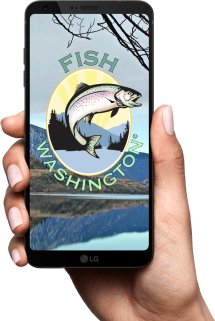
WDFW launched an upgraded version of the Fish Washington mobile application on April 9, now available to download on both Apple iOS and Android devices. The new version is designed to run more smoothly while using less data and device memory.
Developers completely rewrote the app’s code, which now features a single code base for both iOS and Android platforms. This means a smaller app size, less frequent updates, and fewer bugs. Other improvements include:
- Location-enabled United States Geological Service (USGS) river gauges.
- More consistent emergency regulation delivery.
- Map upgrades.
The new version shows the full water body name and description on emergency regulation cards. With a data connection, the app also includes National Oceanic and Atmospheric Association (NOAA) tidal predictions for marine waters and portions of the Columbia River, as well as river gauges from multiple data providers. Users can ask questions, make suggestions, or report issues by emailing MobileAppDev@dfw.wa.gov. Learn more in our news release.
WDFW to phase out recreational fishing and shellfishing hotlines
For several decades, WDFW provided phone hotlines where people could listen to prerecorded messages about fishing seasons and rule changes. In the years since we established the hotlines, WDFW launched several new options to find accurate, up-to-date fishing information. In summer 2024, we are phasing out the phone hotlines for recreational fishing and shellfishing. There are no changes to the commercial hotlines.
There are many places to find WDFW fishing regulations and information. We encourage anglers who used the prerecorded hotlines to take advantage of one of the web, mobile app, or other customer service phone options we offer. Visit our Fishing Hotlines Page to see the full list of new options and find more information.
Hunting opportunities and news
For an overview of hunting in Washington and how to get started, visit our Hunt Washington blog post.
Buy your 2024 hunting license
With summer in full swing, Washingtonians will need to buy 2024-2025 recreational hunting and fishing licenses. People can buy licenses from WDFW’s licensing website, WDFW regional offices, or hundreds of license vendors around the state.
Current hunting regulations are also available online at wdfw.wa.gov/hunting/regulations.
2024-25 hunting regulations
The 2024-25 Game Bird and Small Game Hunting Regulations and 2024 Big Game Hunting Regulations pamphlets are available online and at hundreds of license dealers around the state. The updated rules can help hunters make decisions about how to spend their time in the field.
Current hunting regulations are also available online at wdfw.wa.gov/hunting/regulations.

General deer and elk seasons open in October
Washington’s statewide general modern firearm deer season begins on Oct. 12, followed by general modern firearm elk starting on Oct. 26. Fall black bear and cougar seasons are currently underway.
WDFW biologists have prepared the latest Washington Hunting Prospects, which are now available online. These reports provide guidance and hunting information for each district to help hunters have a successful season.
Scouting is critical for consistent hunting success, especially in the heavily populated North Puget Sound Region. Abundant black-tailed deer, elk, and black bears reside in our region, but they often congregate in areas where they can avoid hunters and other outdoor recreationists while still finding quality food sources, such as private lands, riparian areas, thick forests, and backcountry basins without roads or trails. The Hunting Prospects are a valuable resource for finding areas where game numbers and past hunter success are higher, improving your odds this season.
Out of state hunters: Bringing bones into Washington is illegal
WDFW reminds out of state hunters of restrictions on bringing deer, elk, moose, or caribou into Washington if harvested outside the state, or within the 100 series GMUs located in Eastern Washington. To prevent the spread of chronic wasting disease (CWD), animals should be boned out at the site of harvest if possible. Only deboned meat, cleaned skulls, antlers, hides, and specific tissues for research or taxidermy are allowed for transport. Visit WDFW’s website for CWD information, regulations, and testing instructions.
Waterfowl season takes flight
Statewide duck hunting seasons take flight Oct. 12-20 during the early season, followed by the regular season opening daily beginning Oct 23. Goose hunting also opens Oct. 12 in GMAs across the state; season lengths vary by location.
Hunters are reminded to check the migratory waterfowl regulations for specific season dates and for detailed rules and bag limits. Tens of millions of ducks and geese use the Pacific Flyway, and Washington is routinely ranked among the best states in the U.S. for waterfowl hunting, with diverse species and opportunities from coastal bays and marshes to farm fields, pothole lakes, and big rivers.
WDFW lands in the North Puget Sound Region provide some of Washington's most consistent waterfowl hunting. Check out our Hunt Planner webmap for places to go, or visit our Skagit Wildlife Area Waterfowl Hunting Guide (PDF) for tips.
Please note that the Skagit Headquarters Unit of Skagit Wildlife Area (also known as Wiley Slough) remains closed at this time for construction, but is expected to reopen to the public later in 2024.
Forest grouse hunting continues
Grouse hunting seasons open Sept. 15 through Jan. 15. Starting in 2021, the start of this season was pushed back two weeks to reduce the harvest of breeding-age hens and ultimately increase forest grouse abundance and availability for hunters.
Ruffed grouse are common in forested foothills of the Puget Sound Region and throughout much of Washington, often near riparian areas. Sooty grouse (the coastal variation of blue grouse (PDF)) are found in mid-elevation conifer forests. Spruce grouse can be found on alpine ridgelines and forests near the Cascade Crest.
Black bear hunting season open through Nov. 15
The fall black bear hunting dates are Aug.1 – Nov. 15. More information including area restrictions is available in the 2024 Big Game Hunting Regulations.
Hunters are urged to not shoot a female with cubs. Bait or hounds are not allowed for bear hunting under Washington state law. Successful hunters must submit a tooth sample from their harvested bear, with instructions available at the link below.
Hunters that choose to hunt in GMUs located in grizzly bear recovery areas must successfully complete the annual WDFW online bear identification test. The online test is available through the WDFW Wild System or our Bear identification program webpage.
Be aware of avian influenza (bird flu)
As bird migrations resume, there is a chance we could also see a resurgence in highly pathogenic avian influenza (HPAI or commonly known as bird flu) to the state. The H5N1 virus of avian influenza is making the rounds again, especially in areas of Western Washington. This is confirmed by WDFW testing of sick or dead wild birds and U.S. Department of Agriculture surveillance of hunter-harvested birds.
Hunters are encouraged to take precautions to protect themselves and their dogs from the virus. WDFW has specific precautions on our avian influenza webpage under “Human HPAI Safety.” If you encounter a sick or dead wild bird, please report it via our online reporting tool.
New, prospective hunters must complete hunter education
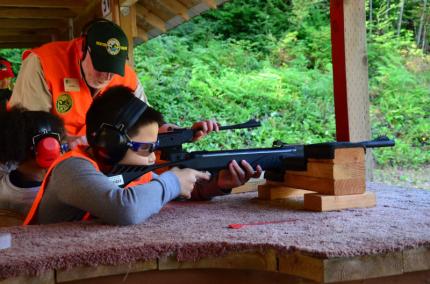
Before hunting seasons start, be sure to complete your hunter education course.
Students may choose between a traditional classroom or hybrid course. The traditional course is a multi-session instructor-led training with an average of 15 hours of instruction. The hybrid course consists of a self-paced online class followed by a field skills evaluation by certified instructors.
Prospective hunters can learn more about hunter education requirements and register for either a traditional or hybrid course by visiting WDFW’s hunter education webpage.
Per Washington state law, all hunters born after Jan. 1, 1972, must complete a hunter education course in order to buy a hunting license. A hunter education deferral is available for hunters 10 and older who want to try hunting with an eligible licensed hunter before completing a hunter education course themselves.
Hoof disease in elk
As many hunters know, Treponeme-Associated Hoof Disease (TAHD) has spread among elk in Western Washington in recent years, including in the North Cascades Elk Herd (PDF). While elk are susceptible to many conditions that cause limping or hoof deformities, the prevalence and severity of this new affliction – now known as treponeme-associated hoof disease (TAHD) – suggests something different.
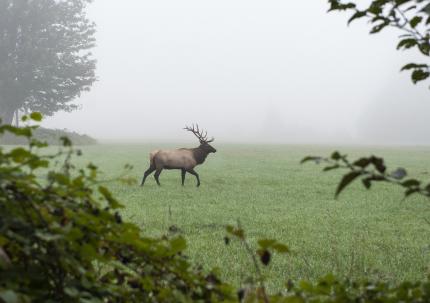
In 2021, WDFW implemented an incentive-based pilot program to encourage Western Washington (400, 500, 600 series GMUs) hunters to harvest limping elk, potentially reducing prevalence of the disease over time. General season or permit hunters can choose to participate in the program by submitting elk hooves at one of the many collection sites in western Washington.
See the WDFW website for the locations of collection sites. Hunters that submit hooves with signs of TAHD (for example, abnormal hooves) will be automatically entered into a drawing for a special incentive permit for the following license year. Multiple bull permits in western Washington with season dates of Sept. 1 – Dec. 31 will be awarded. Additionally, all participants will receive a custom, waterproof license holder.
What hunters can do to help:
- Harvest a limping elk from any 400, 500, 600 series GMUs
- Turn in your elk hooves along with complete registration forms at one of several collection sites in western Washington
- Report elk: Hunters can help WDFW track TAHD by reporting observations of both affected and unaffected elk on the department’s online reporting form.
- Clean shoes and tires: Anyone who hikes or drives off-road in a known affected area can help minimize the risk of spreading the disease to new areas by removing all mud from their shoes and tires before leaving the area.
Head to myWDFW.com for info on hunting, angling, and more
WDFW has rolled out a promotional website for all things hunting, angling, foraging, recreating, and more. At myWDFW.com, you’ll find informative how-to articles on the season’s major fishing and hunting opportunities, as well as a portal to online license sales and a regular update on WDFW’s latest Life Outdoors articles.
Each quarter, new fishing and hunting highlights are posted to help you get ready and take part in Washington’s current and upcoming opportunities. Dedicated to current agency promotions, outdoor recreation information, and educational content, myWDFW.com preps you to meet with success in the field and on the water.
Wildlife watching and recreation
Searching for places to watch wildlife or recreate on State Wildlife Areas or WDFW Water Access Areas? Visit our Places to Go webpage, Wildlife Area map or Water Access Area webpage for ideas.
Or visit our wildlife viewing webpage for more information and tips on wildlife watching!
Wild edible foraging
Mushrooms are highly sought after in autumn especially as the first major rainfalls occur in October and early November, and before the first frost sets in. Top priority when gathering mushrooms is being able to identify what you’re picking before you dish it up to eat. Safety comes first, and nobody enjoys getting sick or even worse winding up in the emergency room. Find helpful tips on mushroom gathering and identification in the WDFW blog.
Watchable Wildlife: Animals are on the move
Wildlife is on the move as animals travel thousands of miles to or from Washington. Welcome the returning salmon by visiting a local salmon viewing site or track migrating bird species in real-time with the National Audubon Society’s interactive migration map.
Did you know bats can migrate, too? This spooky season, you can learn more about bats and how they migrate (and how to help if you find one) on our webpage.
Wild Washington Youth Education
It’s officially spooky season, the perfect time to spotlight animals that come alive at night. From bears and bats to moths and muskrats, many creatures in Washington are most active after dark. Celebrate these nocturnal residents by carving them into your holiday pumpkin. We’ve created five free pumpkin carving templates featuring Washington animals just for you.
Learn more about out Wild Washington Youth Education program and lesson plans. Or find other family education resources on this page.
Feeding wildlife
Many well-meaning Washington residents in urban and suburban areas enjoy feeding deer in their yards. Although some people see this type of feeding as helping these animals, it can hurt them and potentially cause illness and death for the animal. Learn more about how to help us keep wildlife wild (PDF) (PDF) by following the tips on our website.
Practice black bear awareness
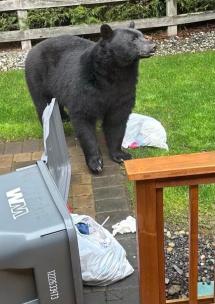
Black bears are common throughout Washington, including suburban areas. Both when preparing for hibernation and awakening from it, they look for high-calorie foods that are easy to get. These may include garbage, bird feeders (both seed and liquid), fruit trees, and pet food.
As human populations encroach on bear habitat, people and bears have greater chances of encountering each other. Food sources provided by humans, whether intentionally or not, can attract bears. Removing these attractants is the best way to encourage bears to move along and focus on natural food sources
Ask your local waste management company if bear-resistant containers are available or if individually purchased bear-resistant containers are compatible with the company’s equipment. Secure your garbage cans, such as in a shed or garage, and put them out the morning of pickup — not the night before. To help reduce odors, freeze meat and fish waste before disposing of it and spray garbage cans with disinfectants.
More information on living with bears is available on our website.
Conserving species and habitats
Looking for more info on wildlife conservation and species management around Washington? Check out our Bi-Weekly Wildlife Program reports.
Biodiversity in Washington video series
Biodiversity supports all life in Washington and across the globe, from open wild spaces to backyard gardens. Washington is home to a wide spectrum of ecosystems, spanning from vast coastal mudflats, eelgrass beds and rocky reefs to temperate rainforests and high alpine meadows to arid grasslands and sagebrush steppe. Our incredibly biodiverse state provides habitat for a variety of native plant, animal, and fungi species, both common and rare. Many of these species, however, face mounting challenges to survival.
Learn more in our new video series on YouTube.
State Wildlife Action Plan survey available
In August 2024, the Washington Department of Fish and Wildlife (WDFW) hosted a public webinar to discuss the update to the State Wildlife Action Plan (SWAP). This public meeting kicked off a year-long public engagement process to revise and update Washington’s SWAP. In the meeting, WDFW shared an update on the timeline for the 2025 SWAP revision and opportunities for public participation during the year-long process. This was the first of three public meetings for the public to participate and offer insights on the revision.
WDFW staff presented general information on the SWAP, its purpose in conservation in Washington and the U.S., and an overview of the revision. The public can now participate in a scoping survey that will be open until Nov. 15, 2024. You may also leave a general comment at (855) 925–2801 using project code 10616. General comments will be incorporated into our public process.
Habitat at Home
Preparing your garden for fall? Think of the wildlife! Birds will feast on the seeds of dead flower heads and bees will nest in hollow stems. Leave your dead flowers and herbs standing through the winter and cut them back in the spring, preserving the stems (PDF) (PDF). You’ll find that pollinating insects nest in these hollow stems, their larva emerging in fall to pollinate your garden and beyond!
Learn more in this blog post from the Xerces Society.
WDFW, DNR announce $8.5 million in funding for Puget Sound restoration and protection efforts
These investments support non-profit organizations, conservation districts, academic institutions, and state, tribal, and local governments that are working to restore and protect Puget Sound. Many of the 21 funded projects will allow these organizations to add needed capacity to continue ongoing work and foster new partnerships to benefit Puget Sound’s environments, from upland forests to the nearshore. Learn more in our news release.
Look out for invasive European green crabs
Summer fun is just around the corner. While you enjoy your favorite outdoor activities around Washington's waters, be on the lookout for European green crabs.
Use our simple "5 Point" approach to identify this aquatic invasive species:
- 5 points outside of the eyes
- 4 inches or smaller
- 3 rostral bumps between the eyes
- 2 semi-flattened rear swimming legs
- 1 enormous threat to our native shellfish and aquatic habitat
Join us in the fight against this invasive species. If you spot a European green crab using these 5 points, report it at wdfw.wa.gov/greencrab.
Join the WDFW team
If you’d enjoy preserving, protecting, and perpetuating the state’s fish, wildlife, and ecosystems while providing sustainable fish and wildlife recreational and commercial opportunities, then check out some of our current job openings or sign up for job alerts. From fish hatchery specialists to environmental engineers and budget analysts to wildlife biologists, a career with WDFW makes a difference.
Volunteer opportunity spotlight
WDFW welcomes volunteers of all abilities who want to contribute to the conservation of fish, wildlife, and habitat. Diverse volunteer opportunities are available, including projects on state wildlife areas and water access areas, habitat restoration projects, hunter education instruction, and assisting at outreach events.
For more information about the volunteer program and upcoming volunteer opportunities, visit the WDFW volunteer webpage.
Wildlife Program biweekly reports
To read reports published prior to 2023, visit the Biweekly Wildlife Program activity reports page.
Meet your Regional Director: Brendan Brokes
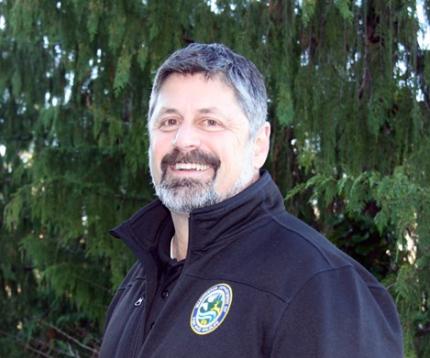
Brendan Brokes, North Puget Sound Region Director (Region 4), holds a master's degree in fisheries science from Oregon State University and has lived in the Pacific Northwest since 1987. He served as the Habitat Program Manager in this region since 2015, after filling a decade-long role as the Assistant Regional Habitat Program Manager.
Before arriving at WDFW in 2001, Brokes worked at Mount Rainier National Park as a researcher and biological technician in aquatic ecology. He also worked with the National Marine Fisheries Service monitoring foreign commercial fisheries compliance.









